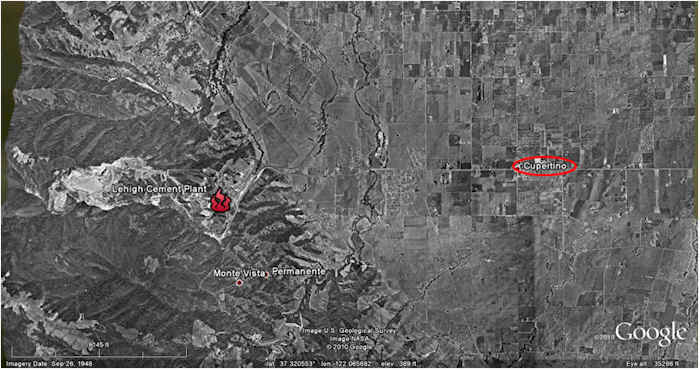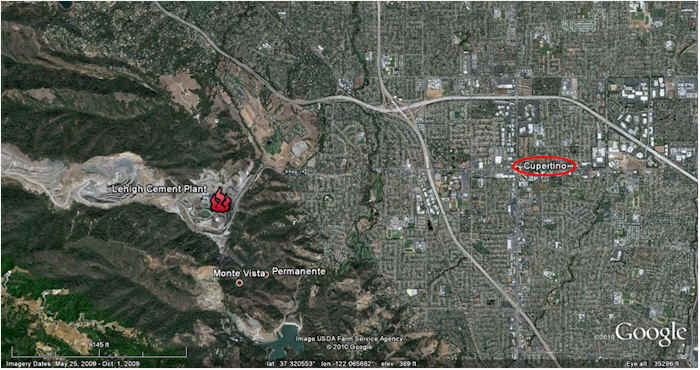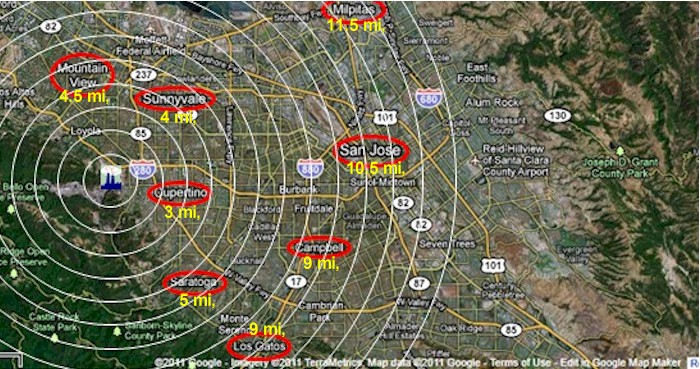In 1939 the city of Cupertino consisted mostly of fruit orchards with very few inhabitants. Kaiser Permanente Cement was the only large manufacturer in the area. Few people were exposed to the dust and air pollutions put out by the cement plant. Trucks bearing raw materials and finished product could travel from the plant to their destination with little impact upon the few residents living nearby. These were the early days of the industrial revolution when almost nothing was known about the health risks of these pollutants. The community around Lehigh slowly and continually grew and orchards were slowly replaced by home and businesses. Then came the 1970's and the semiconductor boom. Apple, HP, and other electronics companies started to spring up in this area and the population exploded as people moved here for high tech jobs. Thus the birth of Silicon Valley. The demand for engineers was great so many of these new residents were well educated.
Today Santa Clara County has almost 1.8 million residents and the city of Cupertino which just 40 years earlier consisted mostly of farms and orchards was replaced by homes and more than 50,000 residents many of whom live in very close proximity to the Lehigh Cement Company..
This cement plant is the single highest source of mercury emissions in the Bay Area (more than any oil refinery in Richmond) and located in one of the highest populated areas in the nation (see Table below). It is in close proximity to many of our schools exposing our children much of the day. Until very recently most residents were oblivious of the cement plant's existence so well concealed is it in the foothills out of sight from public view. Its presence is revealed by the hundreds of trucks loaded with material traveling through Stevens Creek and Foothill Expressway to and from and to the cement plant. However the dust and pollution put out of the cement plant and trucks relentlessly continues to plague residents, especially those living nearby.
The limestone from the quarry used to make cement (clinker) is highly ladened with mercury which is very unique to this area. The limestone is baked in their kiln at 2750oF and completely vaporized into a gas and expelled into our air. This puts residents at risk of prolonged continuous mercury exposure. Some is directly inhaled into our bodies and some is converted to methylmercury and deposited into our soil and waters.
Below are aerial photos of Cupertino and the cement plant and quarry. Lehigh Southwest Cement Plant, the largest stationary emitter of toxic air pollutants in Santa Clara County, is located directly adjacent to Silicon Valley, one of our State's key economic engines as well as a major population center. It is located adjacent to Cupertino and Los Altos and within a few miles from Sunnyvale, Los Altos Hills, San Jose, Mountain View, Saratoga, Palo Alto, Los Gatos, and Campbell. According to the July 2012 Bay Area Air Quality Management District (BAAQMD) staff report, Lehigh is one of the few cement plants in the country located in an urbanized area.
In 2010, it was the ranked as the 3th highest producer of mercury emissions from a cement plant in the United States and arguably higher ranked based upon the latest information (see Table 4 on page 9).
In 1939, there were only about 60,000 People in Santa Clara County

Today there are 1.76 Million People, the large population Exposed to Toxic Pollution from a Cement Plant.

Almost 200,000 residents live within 5 miles of Lehigh, the largest stationary emitter of toxic air pollutants in all of Santa Clara County.

Lehigh Cement next to Cupertino is unique among all other cement plants in the nation. It is a major mercury polluter immediately next to one of the highest population densities in the nation. This multiplies the Health Risks to residents far beyond that established by the EPA and BAAQMD for the rest of the nation. It warrants special consideration for much tighter Toxic Emissions Standards by BAAQMD than any other cement plant.